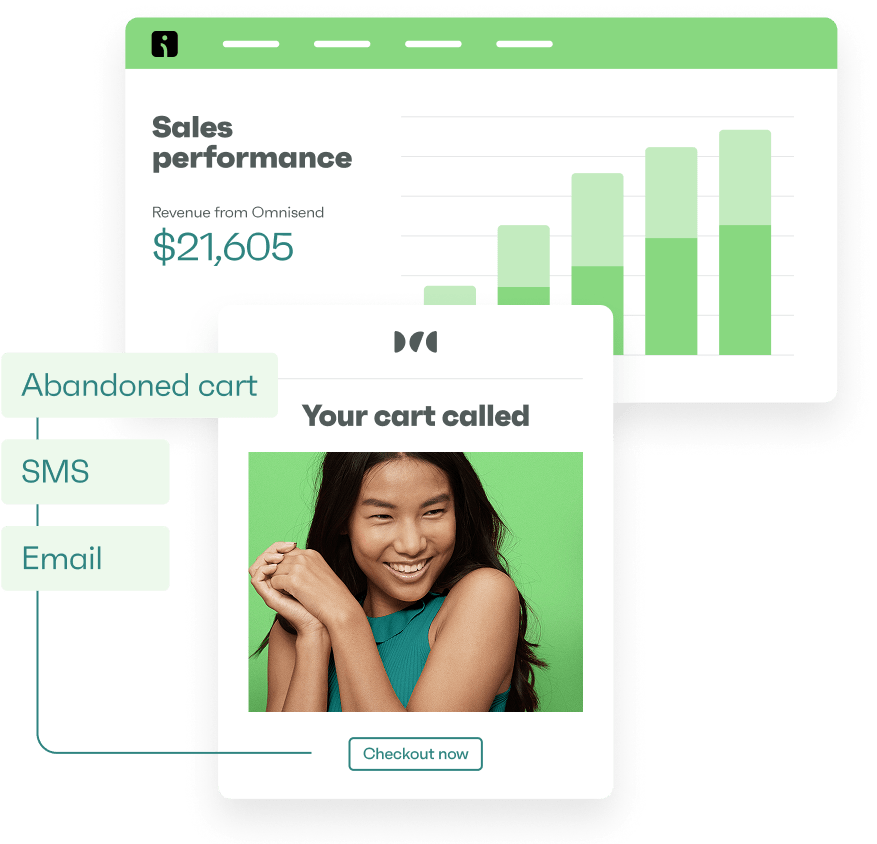Drive sales on autopilot with ecommerce-focused features
See FeaturesMarketing messages used to broadcast to customers — now they start conversations with them. One-way blasts are giving way to two-way conversational messages where customers ask questions, negotiate deals, and get immediate answers.
Each reply is an opportunity to solve problems and close sales instead of losing customers to unanswered inquiries. Your customers might need sizing help, want discounts, or have shipping concerns that you can answer in one channel.
Below, we explore conversational messaging mechanics, examples, implementation tips, and how platforms like Omnisend enable two-way SMS to work at scale.
Quick sign up | No credit card required
Are you new to SMS marketing?
Omnisend’s 2025 Ecommerce Marketing Report reveals which messages generate the highest opens, clicks, and sales. You’ll quickly realize that SMS is a must-have channel in the shopping journey, whether you use it one-way or two-way.
What is conversational messaging?
Conversational messaging turns text marketing into a two-way dialogue. Customers text questions, and you answer them. They reply, you respond. Back and forth, like texting a friend who happens to sell what they need.
How it differs from standard text message marketing
With SMS marketing, you might blast “SALE TODAY!” to 10,000 people in a campaign, or send a text message with a link to a landing page with unique savings as part of a re-engagement flow.
Traditional SMS is impersonal. But when someone texts “Do you have this in medium?” they could be standing in their bedroom, credit card in hand, ready to buy. Your “Yes, two left in stock” turns browsers into buyers. That’s the shift — from megaphone to conversation.
Automation starts the conversation with a quick answer. Additionally, AI can help craft responses within message threads in some apps, but keeping them human matters most. At some point, your customers might want to text a human.
Here’s an example of conversational text messaging via SMS, but it can also be applied to WhatsApp, Messenger, or any other app chat:

Why it works
A large portion of your customers will be resistant to promotional SMS blasts and are more likely to engage with helpful replies.
When someone texts about shipping times and gets real answers, they buy. When they text about product features and get detailed responses, they trust you.
Cart abandonment drops when you text “Still thinking about those shoes?” versus “Complete your purchase!” One starts a dialogue. One pushes sales. You can use SMS in your marketing funnel to answer questions, address concerns, and guide customers to purchase.
Using Omnisend for conversational-style messaging
Omnisend connects with helpdesks like Gorgias to enable SMS conversations. Customer replies become support tickets that agents can answer, with responses flowing back through the same SMS thread.
The integration lets US customers reply naturally to your campaigns. Their messages create tickets in your helpdesk, agents respond, and answers reach customers via SMS. You can trigger automations based on satisfaction scores from these exchanges.
The illustration below shows how it works:

Interested in getting started? Join Omnisend for free.
Additionally, Omnisend triggers automated, personalized SMS at the moments that matter.
Someone abandons their cart? Send “That jacket still on your mind?” instead of “Complete your purchase!” Someone signs up? Text them as if they had just walked into your store.
The power isn’t in back-and-forth chatting but in sending messages that feel conversational. Write like you’re texting a friend. Use their name. Reference what they browsed. Make each automated message feel like it came from a human who noticed what they’re doing.
Benefits of conversational messaging
When your brand talks with customers instead of at them, everything changes:
1. Relationships form
A customer texts about sizing. You help them find what fits. Next time, they come to you first because you helped. People remember who was useful.
2. People respond
Text customers about their recent purchase, and most will answer. Send mass sale announcements, and almost no one replies. The difference is personal relevance — one message matters to them, the other doesn’t.
3. Support becomes manageable
Most questions are simple. What time do you close? Do you ship to Canada? Let automation handle these while your team tackles more complex problems.
4. Faster sales and service
Text conversations close deals quicker. A customer texts about a product, you answer their question, and they buy. What used to take multiple emails over days happens in minutes. Same for service issues — quick text exchanges replace long support tickets.
5. It works at every customer stage
Regular check-ins work better over text. A quick message after purchase shows you care. A helpful tip later keeps you connected. Unlike email drips and blasts, these feel like genuine conversational communications because they arrive when customers need something.
6. Reaches customers anywhere
People always have their phones. They text while commuting, waiting in line, and watching TV. Your messages reach them wherever they are, whenever they have a moment.
SMS automations will help you reach people at optimal moments. In 2024, automated texts drove 18% of sales from just 9% of volume, with conversion rates 118% higher than campaigns.
Top uses of conversational messaging
Conversational messaging works anywhere customers have questions. Here are the applications that generate revenue and cut costs:
Customer support
Most support tickets are the same basic questions about business hours, return policies, and shipping costs. Automated texts answer these instantly while routing complex issues to agents.
Customers get immediate answers instead of waiting on hold or searching help centers, and your support teams can use conversational messaging to provide additional assistance.
Order management
It’s natural for your customers to want to track their order and ensure everything’s going to plan. Traditional systems force them to call or navigate websites.
With conversational messaging, they text the same number that sent their confirmation. Quick questions get quick answers. Problems get solved before they escalate into complaints.
Abandoned cart recovery
Standard cart reminders send a link back to checkout — simple and effective. But when customers can reply, interesting things happen.
They ask for discount codes. They negotiate on bulk orders. They request payment plans or different shipping options. Some ask when items go on sale.
These responses reveal what would close the deal, turning a reminder into a negotiation that benefits both sides.
Sales conversations
Product announcements that invite questions generate more revenue than broadcast messages. Instead of just announcing new arrivals, ask what customers are looking for.
They tell you what they need, and your team provides relevant suggestions. The back-and-forth reveals buying intent you’d miss with one-way messaging.
Reactivation campaigns
Your inactive customers could respond better to genuine check-ins than discount offers. Ask why they haven’t purchased anything lately, and they might say you don’t sell the right product, or that they had a bad experience, or that they forgot about you.
Address their concern instead of guessing with generic promotions. Honest conversations bring customers back.
Review and feedback collection
Text-based feedback starts conversations that emails can’t. A customer rates their experience low and explains why in their reply. You respond immediately with a solution.
Happy customers who respond positively get asked follow-up questions about what they loved most. These details become testimonials and social proof. The two-way format catches problems early and amplifies positive experiences.
How conversational SMS can grow your business
Conversational SMS goes beyond improving communication and directly increases revenue. Text exchanges could lead to more frequent purchases and higher order values.
Questions kill sales. Two-way texting answers them before buyers give up. Someone unsure about sizing gets measurements. Another customer with a question about shipping gets delivery dates.
These conversational texts build confidence and encourage customers to engage with your brand. Here’s how they directly grow your store:
Reduced cart abandonment
Abandoned carts often mean unanswered questions. Let shoppers text back about those items. Size concerns, shipping times, product details — all resolved through quick exchanges. Remove the guesswork, and carts get completed.
More completed purchases
Every buyer needs different reassurance. Quality guarantees matter to some. Payment plans matter to others. Text conversations surface these needs naturally. Address what actually matters to each person.
Higher repeat purchase rates
Text conversations create familiarity. Next time these customers need something, they return to where they know they’ll get answers. Easy access to help becomes a competitive advantage and provides an opportunity to cross-sell and upsell.
Better customer retention
Timely check-ins work. Not constant pestering — just relevant messages when they make sense. Previous buyers appreciate updates on new items that match past purchases. This relevance keeps you in consideration.
Two examples of conversational SMS in action
Check out these conversational texts from an ecommerce and physical business:
Example one
A clothing retailer texts customers who left jackets in their cart. “Still thinking about that jacket? Any questions?” The customer replies, asking if it’s warm enough for winter. The store explains the insulation rating and suggests matching gloves. The customer buys both items.
The retailer used conversational business texting to address the warmth concern, then successfully cross-sold matching gloves, doubling the sale from one item to two.
Example two
A salon sends appointment reminders that clients can reply to. “Appointment tomorrow at 2 PM, need to change?” Client texts back asking for 3 PM instead. The salon confirms the new time and fills the original slot. No phone calls needed.
The salon kept its client happy while avoiding a costly gap in its schedule and maintained full bookings without any staff time on the phone.
Features of effective conversational SMS tools
Your SMS platform needs to handle two-way conversations at whatever scale you operate. Look for these capabilities to make conversational messaging work for your business:
Two-way automation and workflows
Set up messages that trigger based on customer actions and process their replies automatically. When someone abandons a cart, your system texts them and handles responses like “What colors do you have?” or “Can I get free shipping?”
The best SMS tools will trigger automatic responses based on the rules and conditions you set, such as sending the first reply within two minutes.
Dynamic personalization
Use customer data to make every message relevant. Pull in your customer’s name, last purchase, browsing history, or location.
“Hi Sarah, still interested in those running shoes you viewed yesterday?” will encourage more engagement than a bland text message. Personalization should extend to responses, adjusting based on what customers tell you.
Customer segmentation
Different groups need different conversations. VIP customers might get priority agent routing, while new customers receive more detailed product information.
Segment by purchase history, engagement level, or preferences to deliver conversations that match where each customer stands.
Omnichannel integration
SMS works best when connected with email, chat, and other channels, so that you can reach customers everywhere.
For instance, a customer might start on SMS, continue via email, then finish with live chat. Good tools maintain context across channels, so your customers never have to repeat themselves.
Conversation analytics
Track more than open rates. Monitor reply rates, conversation completion, revenue per conversation, and common question patterns.
See which automated responses satisfy customers and which trigger agent handoffs. Use this data to improve your conversational SMS marketing.
Compliance management
Your tool should handle opt-ins, opt-outs, and quiet hours automatically. Look for TCPA and GDPR compliance without manual oversight, including consent capture, instant unsubscribe processing, and geographic compliance rules.
Built-in compliance features protect your business from privacy breaches while respecting customer preferences.
Quick-start templates
It’s much easier to launch conversational texting with pre-built flows for common scenarios.
Templates for abandoned carts and checkout, appointment reminders, or customer support provide tested conversation structures.
Customize the language to match your brand and consider the multiple possible conversations your customers might have with you.
How Omnisend meets these criteria
Omnisend meets all the criteria for a top SMS tool:
- Gorgias integration enables two-way SMS by turning customer replies into support tickets
- Liquid templating pulls customer names, locations, and purchase history into your automated SMS
- Segment your audience by purchase history, engagement levels, and custom properties for targeted workflows
- Combines email + SMS in unified automation workflows with shared customer data, plus lets you build separate SMS campaigns
- Pre-built workflows for cart abandonment, welcome series, and order updates
- Tracks SMS performance and sales metrics
- Built-in TCPA compliance with automatic STOP keyword handling
Quick sign up | No credit card required
Best practices for conversational messaging
Good conversational messaging is natural but professional, and it always complies with privacy laws and customer preferences. Follow these tips to refine your approach:
- Use everyday language: That means contractions and questions instead of stiff corporate phrases that sound like a press release
- Use names and context: Reference their recent activity along with their name — mentioning those abandoned sneakers makes your message relevant, not random
- Reply within minutes: Set up instant responses for common questions because customers expect text-speed replies, not email-speed waits
- Make opt-out obvious: Include clear unsubscribe instructions in every conversation — “Reply STOP to unsubscribe” protects you legally and respects customer choice
- Know when to bring in humans: Automation handles basics, but complex issues need people, so set triggers that route emotional or complicated messages to agents
- Match message to audience: New customers need different conversations than VIPs, so segment your lists and adjust tone, offers, and information accordingly
- Keep it scannable: One thought per message, short sentences, clear actions — if customers need to scroll, you’ve written too much
- Create response libraries: Build templates for common questions about shipping, returns, and sizing, then customize them slightly so they don’t feel canned
- Test different approaches: Try various opening lines, timing, and response options because what works for cart abandonment might fail for reactivation
- Study what customers say: Review reply patterns to spot confusion, common questions, and conversation dead ends, then let customer behavior guide your improvements
The future of conversational messaging
SMS conversations will change as AI improves and customer expectations shift. Here’s what’s coming next:
AI-powered conversations
AI will handle multi-step customer service issues without scripted responses. A customer asking about returns can describe their problem, receive troubleshooting help, and process the return in one conversation.
Conversational commerce
Customers will complete purchases inside SMS threads. Text about a product, get answers, apply a discount code, and buy — all without opening a browser. Stored payment details make checkout a one-word confirmation.
Unified channel experiences
One conversation will continue across SMS, email, and chat, letting customers switch channels and pick up where they left off, while your SMS platform tracks the entire exchange, not fragments across different systems.
Data-driven personalization
Real-time behavior shapes each message. If someone always shops for sale items, they’ll see discount options first. Night owls get texts at 9 PM, morning people at 8 AM. Purchase history determines product suggestions.
Making the most of conversational messaging now
Omnisend provides the SMS automation, personalization, and integration capabilities you need to start meaningful customer conversations that generate sales today. You’ll control your entire customer journey across email, SMS, and push.
Quick sign up | No credit card required
TABLE OF CONTENTS
TABLE OF CONTENTS


No fluff, no spam, no corporate filler. Just a friendly letter, twice a month.

 OFFER
OFFER







